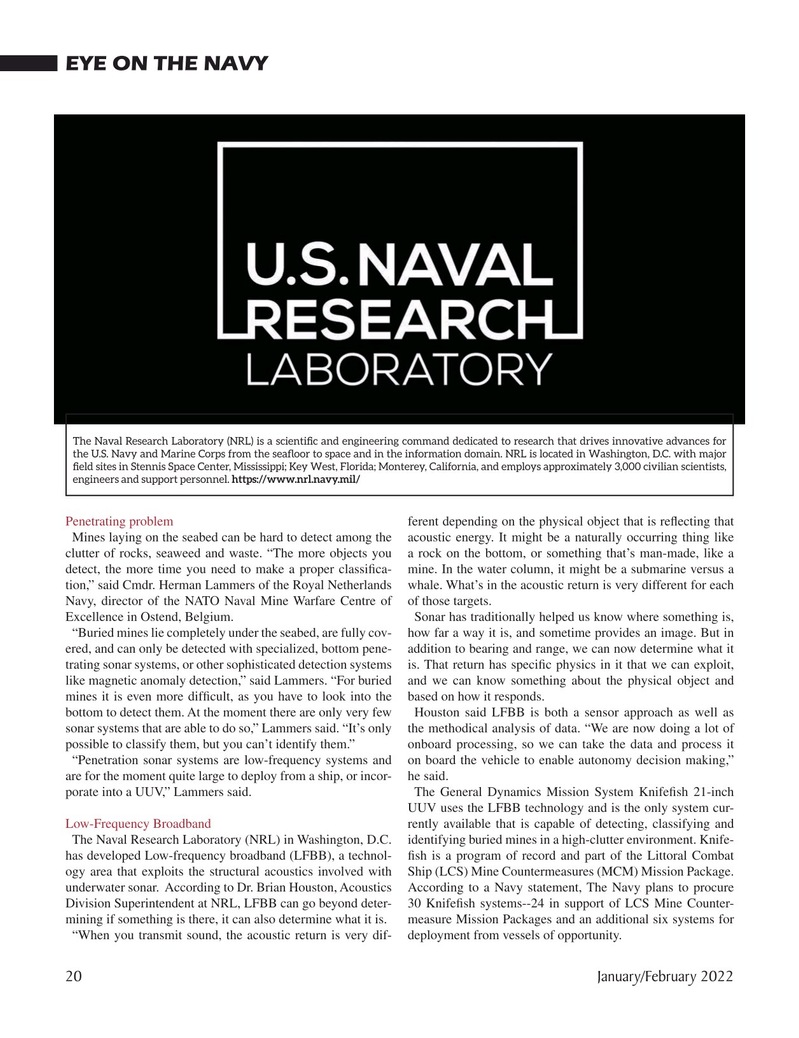
Page 20: of Marine Technology Magazine (January 2022)
Read this page in Pdf, Flash or Html5 edition of January 2022 Marine Technology Magazine
EYE ON THE NAVY
The Naval Research Laboratory (NRL) is a scienti? c and engineering command dedicated to research that drives innovative advances for the U.S. Navy and Marine Corps from the sea? oor to space and in the information domain. NRL is located in Washington, D.C. with major ? eld sites in Stennis Space Center, Mississippi; Key West, Florida; Monterey, California, and employs approximately 3,000 civilian scientists, engineers and support personnel. https://www.nrl.navy.mil/
Penetrating problem ferent depending on the physical object that is re? ecting that
Mines laying on the seabed can be hard to detect among the acoustic energy. It might be a naturally occurring thing like clutter of rocks, seaweed and waste. “The more objects you a rock on the bottom, or something that’s man-made, like a detect, the more time you need to make a proper classi? ca- mine. In the water column, it might be a submarine versus a tion,” said Cmdr. Herman Lammers of the Royal Netherlands whale. What’s in the acoustic return is very different for each
Navy, director of the NATO Naval Mine Warfare Centre of of those targets.
Excellence in Ostend, Belgium. Sonar has traditionally helped us know where something is, “Buried mines lie completely under the seabed, are fully cov- how far a way it is, and sometime provides an image. But in ered, and can only be detected with specialized, bottom pene- addition to bearing and range, we can now determine what it trating sonar systems, or other sophisticated detection systems is. That return has speci? c physics in it that we can exploit, like magnetic anomaly detection,” said Lammers. “For buried and we can know something about the physical object and mines it is even more dif? cult, as you have to look into the based on how it responds.
bottom to detect them. At the moment there are only very few Houston said LFBB is both a sensor approach as well as sonar systems that are able to do so,” Lammers said. “It’s only the methodical analysis of data. “We are now doing a lot of possible to classify them, but you can’t identify them.” onboard processing, so we can take the data and process it “Penetration sonar systems are low-frequency systems and on board the vehicle to enable autonomy decision making,” are for the moment quite large to deploy from a ship, or incor- he said.
porate into a UUV,” Lammers said. The General Dynamics Mission System Knife? sh 21-inch
UUV uses the LFBB technology and is the only system cur-
Low-Frequency Broadband rently available that is capable of detecting, classifying and
The Naval Research Laboratory (NRL) in Washington, D.C. identifying buried mines in a high-clutter environment. Knife- has developed Low-frequency broadband (LFBB), a technol- ? sh is a program of record and part of the Littoral Combat ogy area that exploits the structural acoustics involved with Ship (LCS) Mine Countermeasures (MCM) Mission Package. underwater sonar. According to Dr. Brian Houston, Acoustics According to a Navy statement, The Navy plans to procure
Division Superintendent at NRL, LFBB can go beyond deter- 30 Knife? sh systems--24 in support of LCS Mine Counter- mining if something is there, it can also determine what it is. measure Mission Packages and an additional six systems for “When you transmit sound, the acoustic return is very dif- deployment from vessels of opportunity.
20 January/February 2022
MTR #1 (18-33).indd 20 1/25/2022 9:52:40 AM

 19
19

 21
21
